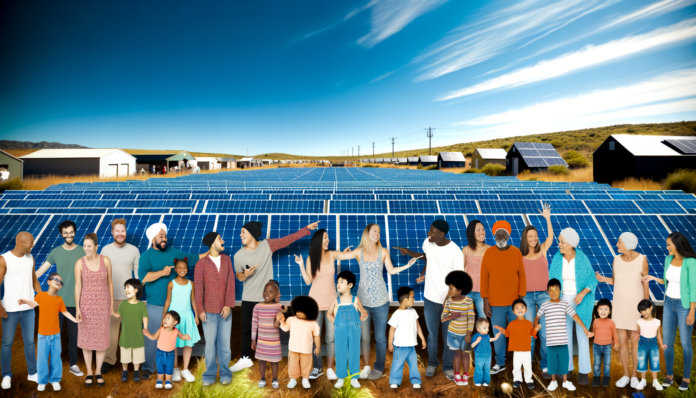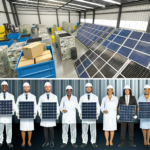Introduction to Community Solar Projects
Definition and Overview
Community solar projects, also known as shared solar or solar gardens, are collaborative solar energy installations that allow multiple participants to benefit from the electricity generated by one or more solar arrays. Unlike traditional solar systems, which are typically installed on individual rooftops, community solar projects are often located on a central site, such as a large rooftop, open field, or other suitable locations. Participants, who can be homeowners, renters, businesses, or organizations, purchase or lease a portion of the solar panels and receive credits on their electricity bills for the power produced by their share of the array.
Community solar projects democratize access to renewable energy by enabling individuals who may not have suitable rooftops or the financial means to install their own solar panels to still benefit from solar power. This model promotes inclusivity and broadens the reach of solar energy, making it accessible to a wider range of people.
Historical Context and Evolution
The concept of community solar has evolved significantly over the past few decades. The earliest community solar projects emerged in the late 2000s as a response to the growing demand for renewable energy and the recognition that not everyone could install solar panels on their property. These early projects were often small-scale and community-driven, relying on grassroots efforts and local funding.
As the benefits of community solar became more apparent, the model gained traction and began to receive support from policymakers and utility companies. In the United States, states like Colorado and Minnesota were pioneers in enacting legislation to support community solar programs, setting the stage for broader adoption. The introduction of virtual net metering, which allows participants to receive credits on their utility bills for the electricity generated by their share of a community solar project, was a key development that facilitated the growth of these projects.
Over time, community solar has expanded beyond small, local initiatives to include larger, utility-scale projects. Advances in solar technology, decreasing costs of solar panels, and supportive policies have further accelerated the growth of community solar. Today, community solar projects are found in many countries around the world, contributing to the global transition to renewable energy.
Importance of Community Solar in Modern Society
Community solar projects play a crucial role in modern society by addressing several key challenges and contributing to a more sustainable and equitable energy system. Some of the primary benefits include:
- Environmental Impact: By increasing the adoption of solar energy, community solar projects help reduce greenhouse gas emissions and reliance on fossil fuels. This contributes to mitigating climate change and promoting environmental sustainability.
- Energy Equity: Community solar projects provide access to renewable energy for individuals and communities that might otherwise be excluded due to financial constraints, lack of suitable rooftops, or other barriers. This promotes energy equity and ensures that the benefits of solar power are more widely distributed.
- Economic Benefits: Community solar projects can stimulate local economies by creating jobs in the solar industry, reducing energy costs for participants, and supporting local businesses. They also provide a stable and predictable source of energy, which can enhance energy security and resilience.
- Community Engagement: These projects foster a sense of community and collective action by bringing people together to invest in and benefit from renewable energy. They can also serve as educational tools, raising awareness about the importance of sustainability and renewable energy.
In summary, community solar projects are a vital component of the renewable energy landscape, offering environmental, economic, and social benefits. They represent a practical and inclusive approach to expanding access to solar power and advancing the transition to a more sustainable and equitable energy future.
Environmental Benefits of Community Solar Projects
Reduction in Carbon Footprint
Community solar projects play a significant role in reducing the carbon footprint of local communities. By generating clean, renewable energy from the sun, these projects help to decrease the reliance on fossil fuels, which are major contributors to greenhouse gas emissions. The collective effort of community members participating in solar projects can lead to substantial reductions in CO2 emissions. For instance, a single community solar project can offset thousands of tons of carbon dioxide annually, equivalent to taking hundreds of cars off the road. This reduction in carbon emissions is crucial in the fight against climate change and helps to create a healthier environment for current and future generations.
Promotion of Renewable Energy
Community solar projects are a powerful tool for promoting the adoption of renewable energy sources. By making solar power accessible to a broader audience, including those who cannot install solar panels on their own properties, these projects encourage widespread participation in renewable energy initiatives. This democratization of access helps to build a more resilient and sustainable energy grid. Additionally, community solar projects often serve as educational platforms, raising awareness about the benefits of renewable energy and inspiring more individuals and businesses to consider sustainable energy solutions. The increased visibility and success of these projects can also drive policy changes and further investment in renewable energy infrastructure.
Conservation of Natural Resources
The implementation of community solar projects contributes to the conservation of natural resources in several ways. Firstly, by reducing the demand for fossil fuels, these projects help to preserve finite resources such as coal, oil, and natural gas. Secondly, solar energy production requires significantly less water compared to traditional power generation methods, which often involve water-intensive processes. This reduction in water usage is particularly beneficial in regions facing water scarcity. Lastly, community solar projects can be designed to minimize land use impacts by utilizing rooftops, parking lots, and other underutilized spaces, thereby preserving natural landscapes and habitats. By conserving these vital resources, community solar projects support the long-term sustainability of our planet.
Economic Impact on Local Communities
Job Creation and Employment Opportunities
Community solar projects are a significant driver of job creation and employment opportunities within local communities. The development, installation, and maintenance of these solar arrays require a diverse workforce, ranging from engineers and construction workers to administrative staff and sales personnel. This influx of job opportunities can have a profound impact on local economies, particularly in areas with high unemployment rates.
- Installation and Maintenance: The construction phase of community solar projects demands skilled labor for tasks such as site preparation, panel installation, and electrical work. Once operational, ongoing maintenance ensures the longevity and efficiency of the solar arrays, providing steady employment for technicians and maintenance crews.
- Administrative and Sales Roles: Beyond the technical jobs, community solar projects also create roles in project management, customer service, and sales. These positions are crucial for managing subscriptions, handling customer inquiries, and promoting the benefits of community solar to potential participants.
- Training and Skill Development: The rise of community solar projects often leads to the establishment of training programs and apprenticeships, equipping local residents with valuable skills in the renewable energy sector. This not only enhances employability but also fosters a skilled workforce that can support future green energy initiatives.
Local Business Growth and Support
The economic benefits of community solar projects extend beyond direct employment. These projects can stimulate local business growth and provide support to various sectors within the community.
- Supply Chain Opportunities: Local businesses can benefit from the supply chain demands of community solar projects. Companies that provide materials, equipment, and services such as electrical components, construction machinery, and transportation can see increased demand, boosting their revenues and growth prospects.
- Partnerships and Collaborations: Community solar projects often involve partnerships with local businesses, non-profits, and educational institutions. These collaborations can lead to innovative solutions and shared resources, further strengthening the local economy.
- Energy Cost Savings: By participating in community solar projects, local businesses can reduce their energy costs through solar credits. These savings can be reinvested into the business, leading to expansion, hiring, and other growth activities.
Increased Property Values
Community solar projects can also have a positive impact on property values within the areas they serve. The presence of a community solar array can make a neighborhood more attractive to potential buyers and investors for several reasons:
- Lower Energy Costs: Properties that are part of a community solar project often benefit from lower energy bills, making them more appealing to cost-conscious buyers. The promise of reduced utility expenses can be a significant selling point.
- Environmental Appeal: As environmental awareness grows, properties associated with renewable energy projects are increasingly seen as desirable. Buyers are often willing to pay a premium for homes and businesses that contribute to sustainability and have a smaller carbon footprint.
- Community Prestige: Being part of a forward-thinking, environmentally conscious community can enhance the overall prestige of a neighborhood. This can attract like-minded individuals and businesses, further driving up property values.
In conclusion, community solar projects offer substantial economic benefits to local communities. They create jobs, support local businesses, and can even increase property values. By fostering economic resilience and growth, these projects not only contribute to a sustainable energy future but also enhance the overall well-being and prosperity of the communities they serve.
Social and Community Benefits
Enhanced Community Engagement
Community solar projects have a unique ability to foster a sense of unity and collaboration among local residents. By participating in these initiatives, community members collectively invest in a shared resource, which encourages active involvement and a stronger sense of ownership. This collective effort often leads to increased community engagement, as residents come together to discuss, plan, and implement solar projects. The shared goal of achieving sustainable energy solutions can strengthen community bonds and promote a culture of cooperation and mutual support.
Educational Opportunities and Awareness
Community solar projects serve as powerful educational tools, raising awareness about renewable energy and its benefits. Schools and educational institutions can integrate these projects into their curricula, providing students with hands-on learning experiences in science, technology, engineering, and mathematics (STEM). Additionally, community workshops and informational sessions can educate residents about the importance of sustainable energy practices, the mechanics of solar power, and the environmental impact of their energy choices. This increased awareness can inspire future generations to pursue careers in renewable energy and advocate for sustainable practices in their communities.
Energy Equity and Accessibility
One of the most significant social benefits of community solar projects is their potential to promote energy equity and accessibility. Traditional solar installations often require significant upfront investments and suitable rooftop space, which can be barriers for low-income households and renters. Community solar projects, however, allow individuals to participate regardless of their financial situation or housing conditions. By providing access to clean energy for all community members, these projects help to reduce energy costs and alleviate energy poverty. This inclusivity ensures that the benefits of renewable energy are distributed more equitably, contributing to a fairer and more just society.
In summary, community solar projects offer numerous social and community benefits, from enhancing community engagement and providing educational opportunities to promoting energy equity and accessibility. These initiatives not only contribute to a more sustainable future but also foster stronger, more resilient communities.
Challenges and Barriers to Implementation
Financial and Funding Issues
One of the most significant challenges facing community solar projects is securing adequate financial resources. The initial capital investment required for setting up solar installations can be substantial, encompassing costs for solar panels, inverters, batteries, and other essential infrastructure. **High upfront costs** can be a deterrent for many communities, especially those with limited financial resources.
Moreover, traditional financing mechanisms may not always be accessible or suitable for community solar projects. **Limited access to credit** and the absence of robust financial models tailored to community solar can further complicate funding efforts. Innovative financing solutions, such as community-based financing, power purchase agreements (PPAs), and green bonds, are emerging but are not yet widespread.
Regulatory and Policy Hurdles
The regulatory landscape for community solar projects can be complex and varies significantly across different regions. **Inconsistent policies and regulations** can create uncertainty and hinder the development of community solar initiatives. For instance, some areas may lack clear guidelines on grid interconnection, net metering, or incentives for renewable energy projects.
Additionally, **bureaucratic red tape** and lengthy permitting processes can delay project timelines and increase costs. Navigating these regulatory hurdles requires significant expertise and resources, which may not be readily available to all communities. Advocacy for more streamlined and supportive policies is crucial to overcoming these barriers.
Technical and Logistical Challenges
Implementing community solar projects involves several technical and logistical challenges. **Site selection** is a critical factor, as it requires identifying suitable locations with adequate sunlight, minimal shading, and proximity to the grid. Urban areas may face space constraints, while rural areas might struggle with grid connectivity.
**Technical expertise** is another significant challenge. The installation, operation, and maintenance of solar systems require skilled personnel. Many communities may lack access to trained technicians, leading to potential issues with system performance and longevity. Capacity-building programs and partnerships with technical institutions can help bridge this gap.
Furthermore, **logistical challenges** such as the transportation of solar equipment to remote areas, the integration of solar power into existing grid infrastructure, and the management of energy storage systems add layers of complexity to project implementation. Addressing these challenges requires coordinated efforts and innovative solutions tailored to the specific needs of each community.
In summary, while community solar projects offer numerous benefits, they also face significant challenges related to financing, regulatory frameworks, and technical logistics. Overcoming these barriers will require collaborative efforts, innovative solutions, and supportive policies to ensure the successful implementation and sustainability of community solar initiatives.
Case Studies of Successful Community Solar Projects
Urban Community Solar Initiatives
Urban areas, with their dense populations and limited space for individual solar installations, have seen significant benefits from community solar projects. One notable example is the **Brooklyn Microgrid** in New York City. This initiative allows residents to buy and sell locally generated solar energy within their community, fostering a sense of energy independence and sustainability. The project not only reduces the carbon footprint but also enhances energy resilience in the face of potential grid disruptions.
Another successful urban project is the **Washington, D.C. Solar for All** program. This initiative aims to provide the benefits of solar energy to 100,000 low-to-moderate income households by 2032. By leveraging rooftops of public buildings and other available spaces, the program has made significant strides in reducing energy costs for residents while promoting environmental stewardship.
Rural and Off-Grid Solar Projects
Rural areas, often characterized by vast open spaces and lower population densities, present unique opportunities and challenges for community solar projects. The **Farmers Electric Cooperative** in Kalona, Iowa, is a prime example of a successful rural solar initiative. This cooperative has developed a community solar garden that allows members to purchase shares and receive credits on their electricity bills. The project not only supports local agriculture by providing an additional revenue stream for farmers but also promotes renewable energy in a traditionally fossil-fuel-dependent region.
In off-grid areas, community solar projects can be transformative. The **Navajo Tribal Utility Authority** (NTUA) has implemented several off-grid solar projects to bring electricity to remote areas of the Navajo Nation. These projects provide reliable and sustainable energy to households that previously relied on expensive and polluting diesel generators. By harnessing the abundant sunlight in the region, NTUA’s solar initiatives have improved the quality of life for many Navajo families.
Collaborative Efforts and Partnerships
Collaboration and partnerships are often key to the success of community solar projects. The **Colorado Energy Office** has partnered with local governments, utilities, and non-profits to develop community solar gardens across the state. These partnerships have enabled the pooling of resources and expertise, resulting in more efficient and impactful projects. For instance, the **Garfield Clean Energy Collaborative** has successfully implemented multiple community solar projects that serve public buildings, schools, and low-income housing, demonstrating the power of collaborative efforts in achieving sustainability goals.
Another exemplary partnership is the **Solar United Neighbors** (SUN) initiative, which brings together individuals, businesses, and local governments to create solar co-ops. These co-ops leverage collective buying power to reduce the cost of solar installations for participants. By fostering a sense of community and shared purpose, SUN has helped numerous communities transition to renewable energy while saving money and reducing their environmental impact.
In conclusion, these case studies highlight the diverse and far-reaching benefits of community solar projects. Whether in urban centers, rural areas, or through collaborative efforts, these initiatives demonstrate the potential of community solar to drive economic growth, enhance energy resilience, and promote environmental sustainability.
Future Prospects and Innovations in Community Solar
Emerging Technologies and Trends
The future of community solar is bright, driven by continuous advancements in technology and evolving trends. **Emerging technologies** such as bifacial solar panels, which capture sunlight on both sides, and **floating solar farms** that utilize bodies of water for installation, are pushing the boundaries of efficiency and applicability. Additionally, **energy storage solutions** like advanced battery systems are becoming more affordable and efficient, allowing for better management of solar energy and ensuring a reliable power supply even when the sun isn’t shining.
**Smart grid technology** is another significant trend, enabling better integration of community solar projects into the existing power grid. This technology allows for real-time monitoring and management of energy production and consumption, optimizing the use of solar power and reducing waste. Furthermore, **blockchain technology** is being explored to facilitate transparent and secure energy transactions within community solar projects, potentially revolutionizing how energy credits are tracked and traded.
Policy and Legislative Developments
The growth of community solar is heavily influenced by supportive policies and legislative frameworks. In recent years, several states have enacted laws to promote community solar projects. For instance, states like New York, Maryland, and Colorado have implemented policies that streamline the approval process and offer incentives such as tax credits and grants. These measures make community solar projects more financially viable and attractive to investors.
At the federal level, the extension of the **Investment Tax Credit (ITC)** for solar energy projects has been a significant driver of growth. This credit allows for a percentage of the installation costs to be deducted from federal taxes, reducing the financial burden on developers and participants. Additionally, the introduction of **Renewable Portfolio Standards (RPS)** in various states mandates that a certain percentage of energy must come from renewable sources, further encouraging the adoption of community solar.
Potential for Global Expansion
While community solar has seen substantial growth in the United States, its potential for global expansion is immense. Countries with abundant sunlight and high energy costs, such as India and parts of Africa, are prime candidates for community solar projects. These regions can benefit significantly from the accessibility and affordability of solar energy, especially in rural and underserved areas.
International organizations and governments are increasingly recognizing the value of community solar. For example, the **International Solar Alliance (ISA)**, a coalition of solar-rich countries, aims to promote solar energy adoption worldwide. By providing funding, technical assistance, and policy support, the ISA is helping to pave the way for community solar projects in developing nations.
Moreover, the concept of **energy cooperatives** is gaining traction globally. These cooperatives allow communities to collectively invest in and manage solar projects, ensuring that the benefits of renewable energy are shared equitably. This model not only promotes sustainability but also fosters community engagement and empowerment.
In conclusion, the future of community solar is promising, with technological innovations, supportive policies, and global expansion efforts driving its growth. As these projects continue to evolve, they will play a crucial role in democratizing access to renewable energy, fostering economic resilience, and promoting environmental sustainability worldwide.





